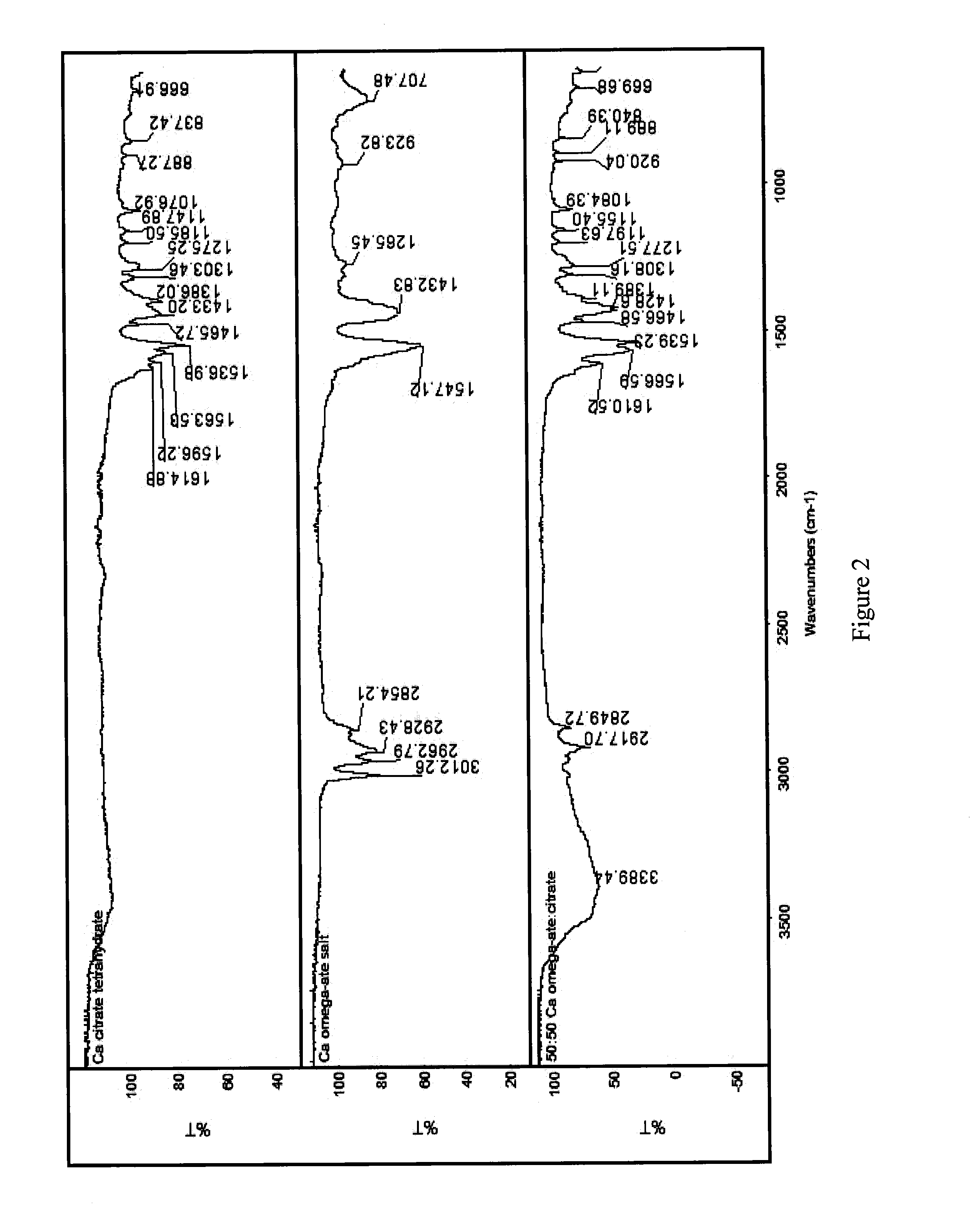Co-precipitated salts of fatty acids
a technology of fatty acids and co-precipitated salts, which is applied in the direction of fatty acid chemical modification, drug compositions, metabolic disorders, etc., can solve the problems of poor flow and processing characteristics of pufa salts, and achieve the effect of altering the fatty acid profile of livestock
- Summary
- Abstract
- Description
- Claims
- Application Information
AI Technical Summary
Benefits of technology
Problems solved by technology
Method used
Image
Examples
working examples
GENERAL PREPARATION AND WORKING EXAMPLES
[0047]The co-precipitated co-salt is produced by preparing a solution of a soluble fatty acid (omega-ate) salt and a co-anion salt. The salt solution is prepared at ambient or room temperature (i.e., approximately 25-32° C.) The salt of the anions can be a sodium salt. Potassium or ammonium are expected to work as well. The soluble salt solution can be prepared two ways. In a first method, a co-anion salt solution is added to a fatty acid salt solution. In a second method, the anions (i.e., the omega-ate ions and the co-anion) are combined and, for example, a sodium solution (i.e., an NaOH solution) is added to the anion solution to form the fatty acid and co-anion salts. In the first noted method, the sodium salt solution of the free fatty acid can be derived from saponifying fish oils, the ethyl or methyl esters of fish oil fatty acids or from transesterification of those oils. The same technique can be applied to seed oils, microbial oils a...
examples
[0050]Table 6 below presents experimental data showing various co-salts that have been produced employing the general co-precipitation procedure described above. Specific and detailed “working examples”, described later, elaborate on the concept. In addition, Table 6 provides the theoretical weight percents of the omega-3 fatty acid (i.e., combined EPA and DHA) and the theoretical weight percent of the cation (i.e., calcium or magnesium). As described above, the theoretical weight percents are calculated assuming an admixture of the omega-ate salt with calcium citrate tetrayhydrate, calcium phosphate, and magnesium phosphate.
TABLE 6Summary of Analysis of Composition of Co-Salts Prepared by Coprecipitation(All %-values are weight %)Total %% Moisture WtTheoretical Wt %TheoreticalCo-Salt Description% DHA% EPA[EPA + DHA]wt % cationLoss by TGAEPA + DHAwt % CationCalcium Citrate Co-Salts% Ca-% Ca-FFACitrate10901.311.663.020.43.019.6109000.10.118.03.019.652487.698.8016.512.07.418.713.55050...
working example a
[0052]Preparation of 50:50 Calcium Omega-3 Salt: Calcium Citrate Tetrahydrate Co-Salt[0053]1. Preparation of Free Fatty Acid Sodium Salt Solution: Assemble a round bottom 2-Liter three-necked flask equipped with a motor-driven Teflon paddle stirrer, a nitrogen purge inlet, a heating mantle, and a 130-mL capacity addition funnel with pressure-equalizing sidearm. Purge thoroughly with nitrogen. Then add 320-mL's degassed deionized water. Continue a slow nitrogen purge throughout the remaining steps.[0054]2. Next, add 46.9 grams of a “free fatty acid” mixture derived from menhaden oil by saponification and having an average equivalent weight of 288 grams / mole.[0055]3. Adjust the temperature of the stirring mixture to 30-32° C. Then add dropwise a solution of 13.0 grams 50% sodium hydroxide dissolved in 100-mL's of degassed deionized water.[0056]4. Preparation of Trisodium Citrate Solution: In a separate 400 mL glass beaker equipped with a magnetic stirbar, and using a stirrer / hot-plate...
PUM
| Property | Measurement | Unit |
|---|---|---|
| temperature | aaaaa | aaaaa |
| equivalent weight | aaaaa | aaaaa |
| temperature | aaaaa | aaaaa |
Abstract
Description
Claims
Application Information
 Login to View More
Login to View More - R&D
- Intellectual Property
- Life Sciences
- Materials
- Tech Scout
- Unparalleled Data Quality
- Higher Quality Content
- 60% Fewer Hallucinations
Browse by: Latest US Patents, China's latest patents, Technical Efficacy Thesaurus, Application Domain, Technology Topic, Popular Technical Reports.
© 2025 PatSnap. All rights reserved.Legal|Privacy policy|Modern Slavery Act Transparency Statement|Sitemap|About US| Contact US: help@patsnap.com



